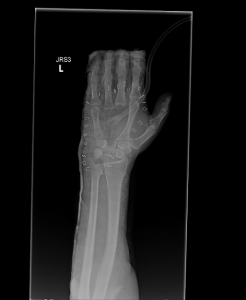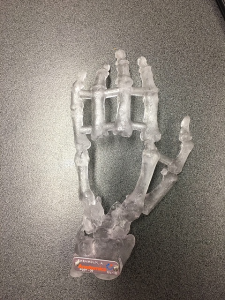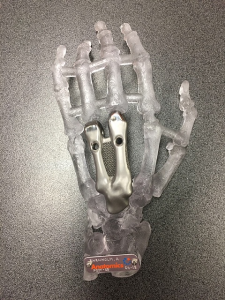Since then, 3D printing has given other Wolverine fans a way to embody him without having to turn to adamantium. But this has gone one step further now, with a story, as Paul D’Urso, MD, a neurosurgeon at Epworth Healthcare and the Executive Chairman of Australian medical device company Anatomics, tells us, about a “Real Life Wolverine.”
D’Urso said, “Anatomics pioneered the use of 3D printing in surgery in 1995 and has helped surgeons in 40 countries with the most difficult & complex reconstructive surgical problems that no other company could provide a solution for.”
 Let’s back up a little first. The five metacarpal bones, which are located between the carpal bones of the wrist and the phalanges of the fingers, make up the intermediate portion of the human hand. Equivalent to the metatarsal bones in the foot, the tops of the metacarpals form our knuckles where they join to the wrist.
Let’s back up a little first. The five metacarpal bones, which are located between the carpal bones of the wrist and the phalanges of the fingers, make up the intermediate portion of the human hand. Equivalent to the metatarsal bones in the foot, the tops of the metacarpals form our knuckles where they join to the wrist.
We’ve seen 3D printed haptic models representing carpal and metacarpal bones during various hand movements created and studied for potential use in preoperative planning for hand surgery, a 3D printed wrist brace for stabilizing a broken metacarpal while healing, 3D printed patient-specific models and surgical guides for metacarpal deformities, and even a 3D printed titanium bone to replace a metacarpal thumb bone.
Anatomics, a not-for-profit company, has plenty of experience using 3D printing in the medical field, such as 3D printing the first titanium sternum and set of ribs and vertebrae. The company recently had to call on this experience to help with an important case.
“This man had a severe workplace injury and lost the bones in the middle of his left hand,” D’Urso told 3DPrint.com. “As there was no ‘off the shelf ‘ solution his hand surgeon, Dr Dan Rowe, called upon Anatomics to reconstruct the patient’s hand with a 3D printed titanium implant.”
Anatomics stepped up to the plate and got to work. Together with Dr. Rowe, engineers from the medical device company designed a 3D printed, patient-specific metacarpal implant to replace the patient’s two missing metacarpals and missing capitate that had resulted from his injury.
The implant was designed with titanium mesh, which makes soft tissue ingrowth possible once it’s inserted into the patient’s body. Titanium is biocompatible, with a high resistance to corrosion, both of which combine to allow bone to grow. These qualities make it the perfect material for medical implants, once it’s combined with 3D printed lattice structures.
“The implant was designed to articulate with the other bones in the hand and had special channels in it that allowed the tendons to secure it in position,” D’Urso tells us.
“The implant contained a porous lattice to allow for tissue integration.”
During the patient’s hand reconstruction surgery at Greenslopes Private Hospital in Queensland, Dr. Rowe implanted the 3D printed titanium metacarpal. D’Urso tells us that “Dr Rowe is very pleased with initial results!”
Okay, so the patient didn’t actually end up being a real Wolverine, as only a very small portion of his bones were replaced with metal, but he was still part of something pretty amazing. Innovations like this one are what make 3D printing so important in the medical field. While I imagine the patient still didn’t have the easiest recovery – he did lose the bones in the middle of his hand, after all – I’m willing to bet his quality of life will be better with a 3D printed implant made specifically for his hand than it would be with an off-the-shelf implant, or worse, no implant at all.
Discuss this story and other 3D printing topics at 3DPrintBoard.com or share your thoughts below.
[Images provided by Paul D’Urso, MD]Subscribe to Our Email Newsletter
Stay up-to-date on all the latest news from the 3D printing industry and receive information and offers from third party vendors.
You May Also Like
New Report: Semiconductor Industry to See $1.4B in 3D Printing Revenues by 2032
“The semiconductor sector has become the most strategically significant area of global industry.” Truer words are hard to come by when it comes to the modern world, and they are...
Will Photonic-Crystal Lasers Revolutionize 3D Printing?
Powder bed fusion (PBF) for metals and polymers predominantly utilizes lasers as the primary heat source. Some directed energy deposition (DED) technologies also employ lasers, while various vat polymerization methods...
3D Printing Unpeeled: Orbex Investment, IndoMIM and HP, Ultrasonic Waves
INDO-MIM has bought three HP Metal Jet S100 printers, operating two in India and one in Texas. This is a win for HP because the company has deep experience in...
3D Printing Webinar and Event Roundup: April 21, 2024
It’s another busy week of webinars and events, starting with Hannover Messe in Germany and continuing with Metalcasting Congress, Chinaplas, TechBlick’s Innovation Festival, and more. Stratasys continues its advanced training...


































